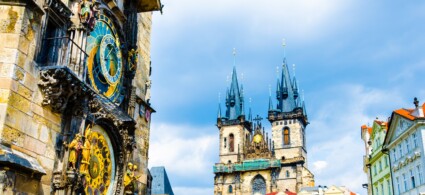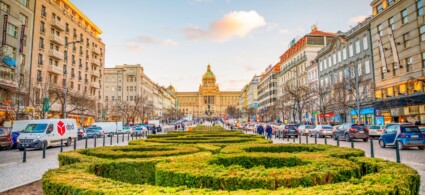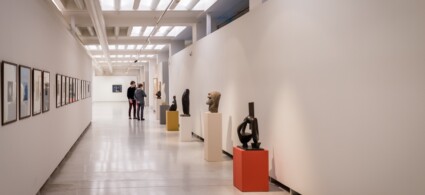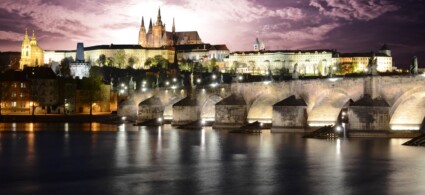

The magnificent Prague is without a doubt one of the most beautiful cities in Europe. Its classical elegance, its many monuments, streets and squares and, above all, the magnificent Castle make it a capital city not to be missed, a destination for tourists from all over the world every year.
Prague is easy to get around on foot because its historical centre is compact. However, at first glance, it may be difficult to determine which are the best attractions and things to see in the city. That is why here is a list designed to help travellers discover the sights and places not to be missed.

The Prague Castle complex dominates the city from the hill. It dates back to the 9th century and is the largest ancient castle in the world, covering an area of approximately 70,000 square metres. Today, there is no trace of the old walls, but in their place has risen an elegant complex called Hradcany where numerous monuments and sights can be found, starting with the Presidential Palace of the Czech Republic where the President lives.
Next to it stands the beautiful St. Vitus Cathedral, but also in the immediate vicinity is St. George’s Basilica, a monastery, as well as palaces, gardens and watchtowers. It is also home to the National Gallery, one of the most important museums in the Czech Republic, housing a collection of Bohemian art and exhibitions dedicated to the history of the country.

The Charles Bridge is the most famous and most photographed bridge in Prague. It crosses the Vltava River, connecting the Old Town to the Mala Strana district, and is a must-see stop on any tour of the city.
Its construction began in 1357 and until 1841 it was the only point of crossing the river. Protected by three towers, two on the Mala Strana side and one on the Old Town side, it is decorated with 30 statues, mostly in Baroque style, dating back to the 18th century. Those we see today, however, are only replicas.
Along the Charles Bridge, entirely pedestrianised and a very pleasant place to take a stroll around the city, street artists perform daily, but there are also stalls selling small souvenirs or painters.

St. Vitus Cathedral, also dedicated to Saints Wenceslas and Adalbert, is the seat of the city’s archbishopric. It is a perfect example of Gothic architecture and is the largest church in the country at 124 metres long by 60 metres wide. It is located within the Prague Castle District and is the repository of Holy Roman Emperors and Kings of Bohemia.
It is one of the most visited places in the city and its construction dates back to 1300, although it was rebuilt several times during its history due to wars, sieges and fires.
The most beautiful part of the Cathedral is the Chapel of St Wenceslas, inside which are the saint’s relics. The elegantly decorated walls and frescoed ceilings make it an absolute must on a visit here.

Old Town Square is the beating heart of Prague’s historical centre. Also known by its Czech name Starometske Namesti, it is overlooked by some of the city’s most important buildings, such as the Church of St. Nicholas, the Town Hall with its astronomical clock, and the Church of St. Mary of Tyn. In the centre of the square stands the monument to Jan Hus, placed here to celebrate the 500th anniversary of his death.
The square is among the busiest in Prague, and constantly taken over by tourists at all hours of the day and night. The characteristic Christmas markets are held here in December, and it is the perfect place to sip a good beer or sample some local delicacies in one of the many restaurants that line the square.
Find out more about the Old Town Square

The Astronomical Clock in the Prague Town Hall tower is located on the Old Town Square and is one of the most popular attractions for tourists visiting the city. Dating back to the 14th century, as well as being very aesthetically pleasing, it comes alive at the stroke of every hour.
Next to the clock are four statues: a skeleton, a Turk, a man with a mirror and a traveller, representing the deadly sins, which come to life at every hour to the delight of tourists who admire and photograph what is happening from below, celebrating the arrival of the new hour of the day with thunderous applause.

Wenceslas Square is another of the must-see places in Prague. It is actually of a very unusual shape, as it is a good 750 metres long and only 60 metres wide, making it a large boulevard. It is overlooked by two important monuments, the Prague National Museum and the Grand Hotel Europa.
It was here that the Prague Spring, the uprising of the city’s inhabitants against the Soviets, began when the student Jan Palach set himself on fire on 16 January 1969. But even in the past, Wenceslas Square was the site of popular demonstrations: it was here that Czechoslovakia’s independence from the Austro-Hungarian Empire was declared on 28 October 1918.

The Jewish quarter, called Josefov, is the area where Prague’s Jewish community has lived since the 10th century. Here you will find some monuments that should not be missed during a visit to the city, such as the old Jewish cemetery, closed in 1787, and some interesting synagogues such as the Spanish Synagogue or the Pinkasova Synagogue, which became a symbol of the Prague Jews exterminated during World War II by the Nazis, who numbered more than 80,000.
Today, Josefov is a trendy and fashionable district, very pleasant to visit. Prague’s Jewish community continues to exist, and can be found in the Old Synagogue, the Upper Synagogue and the Jerusalem Synagogue, located, however, in the Nove Mesto district.

The Dancing House is a Prague building designed by Vlado Milunic and Frank Gehry in the Nove Mesto district. It dates back to the mid-1990s and its distinctive style, although initially controversial among locals, has made it one of Prague’s must-see attractions.
It is also known by the name Fred And Ginger, the names of Fred Astaire and Ginger Rogers, as the building is reminiscent of a dancing couple. It was originally supposed to be a cultural centre, but was never realised. In return, on the seventh floor there is an excellent restaurant from which you can enjoy a wonderful view of Prague from above.

The Golden Lane, in Czech Zlata Ulicka, is a small street located in the Castle District. Its origins date back to the 16th century, when it was the area where the emperor’s guards stayed.
It takes its name from the goldsmiths who lived in this street during the 17th century. Its alternative name, Alchemists’ Alley, is actually a stretch: no alchemist ever lived or worked here.
It is one of the most interesting sights in Prague thanks to its small, brightly painted houses, most of which now house souvenir shops, and even a museum of medieval armour.

The Vltava is the largest river in the Czech Republic and flows through the centre of Prague, of which it is one of the symbols. It is not too long, only 430 kilometres, but in Prague it reaches truly enormous dimensions.
In Prague, it is crossed by 18 bridges that connect the two banks of the city. A walk on both is a must: on one side you can admire the Castle District, on the other the church spires of the Old Town.
The Vltava in Prague has flooded twice in recent years: in 2002 and 2013, leaving behind various damages, some of which took years to repair.
Read moreBuy the ticket from 48,00 €


















City Card allow you to save on public transport and / or on the entrances to the main tourist attractions.
